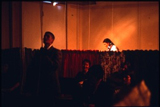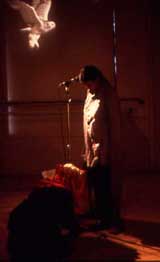Realms of Habitation
|
At the centre of this traumatized landscape, and present throughout the exhibition, was McKeough herself. Her role was that of a maintenance worker, going about a series of well-intentioned but essentially fruitless tasks: feeding the cigarette butts to the trees so that they might eject them from the forest, herding an itinerant bag of trash back towards the houses from which it came, and guiding visitors safely across the road. Her role as crossing-guard was essential, since a motorized automobile wheelbase would intermittently travel the length of the roadway. In fact, McKeough’s primary occupation was to keep this car on the road by dragging her body behind it and using her weight and strength to adjust its course. The exertion required of her to carry out this task is typical of her performances, as if to highlight the tremendous effort required to cope with – either by maintenance of or deviation from – the fractured habitats we construct.
McKeough’s most recent work explores territories of the broadest nature. Slipping By, an installation-performance at Calgary’s Stride Gallery in September and October 2005, was conceived in direct response to the chaotic and defining presence of the street outside the gallery (McKeough 15/May/2006), but it also examined the absurdity of our self-imposed subjugation to time. The gallery’s walls were lined with large analogue clocks whose hands spun madly when triggered by a visitor’s passage before an electric eye embedded in the clock face. Sound recordings associated with each clock depicted in audio form some manifestation of stress or pressure, ranging from urgings to “stop, stop, go, go, go!” and alarming cries of “oh, no!” to sharp horn blasts and sustained penetrating hums. Meanwhile, small electronic cars with full-sized horns mounted on them zipped back and forth along short lengths of track. The three-week installation culminated in a performance during which visitors were permitted to enter singly, at one-minute intervals. As each audience member arrived and claimed a space in the small gallery, she or he would trigger the electric eyes and unleash fresh cacophony into the space. Peace could only be achieved through absolute stillness, but just as the sounds subsided the next visitor would arrive and restart the process. At the centre of the gallery, McKeough, dressed in a dark suit and red tie, hung from the gallery ceiling by a red rope. Her movements were slow and laboured, as though she resided within a different tempo from the frenetic one that dominated the room. Once again, the suspension suggested an ungrounded state, a condition of not fully residing in the territory in which one find’s oneself. |
  |
